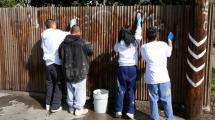Youth who receive special education services under the Individuals with Disabilities Education Act (IDEA 2004) and especially young adults of transition age, should be involved in planning for life after high school as early as possible and no later than age 16. Transition services should stem from the individual youth’s needs and strengths, ensuring that planning takes into account his or her interests, preferences, and desires for the future.
Challenges: Basic Needs, Safety, and Welfare
For some youth, the transition to adulthood presents a number of challenges in meeting their basic needs. They may not be able to find employment that offers health benefits, no longer be included in their parents' insurance, or have become too old to qualify for Medicaid or SCHIP. Finding safe, affordable housing can be a challenge. For youth leaving foster care or juvenile detention facilities, youth who have run away from home or dropped out of school, or youth with disabilities, the challenges can be even greater.
Health, Mental Health, Pregnancy, and Childbearing
- Dropouts have a life expectancy nine years less than the average high-school graduate (Levin, 2005).
- Former foster youth report they find it difficult to secure health coverage in their first years on their own (National Conference of State Legislatures).
- CBO estimates that 60% of former foster youth qualify for some type of publicly funded health program (Medicaid, SCHIP, or another option) (English & Grasso, 2000).
- Between 50 and 75% of incarcerated youth are estimated to have a diagnosable mental health disorder (National League of Cities, 2005).
- Roughly 10 to 12% of all youth will experience a mental health problem significant enough to require short-term special services and treatment at some point in their teenage years (Podmostko, 2007).
- Eighty percent of youth in foster care have received services for mental health issues during placement (U.S. Department of Health and Human Services, Administration for Children and Families, n.d).
- Forty-five percent of homeless youth reported mental health problems in the last year (Burt, 2007).
- Suicide is the third leading cause of death among 15 to 24 year olds (U.S. Department of Human Services, Centers for Disease Control and Prevention, 2011).
- Four years after leaving foster care, 42% of youth have become parents (National League of Cities, 2005).
- Eighteen percent of today's 15-year-old girls will give birth before age 20. One in every three teen mothers is a dropout (National League of Cities, 2005).
- About 50% of street youth have had a pregnancy experience compared to about 33% of youth living in shelters (Greene & Ringwalt, 1998).
Housing
- Each year, 24,000 young people age out of foster care and are expected to transition to independent living (Gardner, 2008).
- Between 11 and 37% of youth who age out of foster care have experienced homelessness (U.S. Department of Housing and Urban Development, 2014).
- Three in ten homeless adults have had experience in the foster care system (Gardner, 2008).
Resources
Got Transition
This program, from The National Alliance to Advance Adolescent Health, is funded through a cooperative agreement from the federal Maternal and Child Health Bureau, Health Resources and Services Administration. Its aim is to improve the transition from pediatric to adult health care through the use of evidence-driven strategies for clinicians and other health care professionals; public health programs; payers and plans; youth and young adults; and parents and caregivers.
Embracing a “Youth Welfare” System: A Guide to Capacity Building
This guide focuses on challenges that state child welfare agencies face when working with youth. To address these challenges, the guide presents the Youth Welfare approach, which outlines how agencies can shift from a child-focused system to a youth-focused system by implementing practices that support youth and their needs. Agencies and others working with youth in care can access the complete guide or download the tools, which include a graphic and several exercises to build staff knowledge and skills in youth welfare.
Providing Health-Care Services for Youth in Care Along the Good-Better-Best Continuum (PDF 4 pages)
This worksheet assists readers in exploring the Youth Welfare approach to service provision in the area of health care. It includes a case description of a young person who is about to transition from foster care, as well as a series of questions designed to guide the reader in crafting a health-care transition plan for the young person using the Good-Better-Best continuum of service provision.
U.S. Department of Health and Human Services
Administration for Children and Families/Family and Youth Services Bureau
Runaway and Homeless Youth Programs
Eligibility: Youth aged 16 to 22 who are unable to return to their homes
Focus: Life skills training
Runaway and Homeless Youth Programs that serve transition-age youth include the Transitional Living Program and the Maternity Group Homes Program.
The Transitional Living Program for Older Homeless Youth promotes the independence of youth between 16 and 22 years old who are unable to return to their homes. Grantees provide housing and a range of services, including life skills training, financial literacy instruction, and education and employment services. Youth might live in group homes or in their own apartments, depending on the program and each young person's independent living skills.
The Maternity Group Homes Program, part of the Transitional Living Program, supports homeless pregnant and/or parenting young people between the ages of 16 and 22, as well as their dependent children. Services are provided for up to 21 months.
U.S. Department of Housing and Urban Development (HUD)
Family Unification Program
Eligibility: Youth aged 18-21 who have aged out of foster care
Focus: Housing
The Family Unification Program provides Housing Choice Vouchers to communities to help assist in the transition of youth out of foster care. The Public Housing Authority administers the vouchers and the child welfare agency provides supportive services to youth. Vouchers are used to provide rental assistance to youth aged 18 to 21 who transition from foster care or who leave foster care at age 16 or older. The voucher subsidizes the rent of eligible youth for up to eighteen months.
References
Burt, M. R. (2007). Understanding homeless youth: Numbers, characteristics, multisystem involvement, and intervention options. Testimony before the U.S. House Committee on Ways and Means, Subcommittee on Income Security and Family Support. Retrieved from http://www.urban.org/UploadedPDF/901087_Burt_Homeless.pdf (PDF, 14 pages)
English, A., & Grasso, K. (2000). The Foster Care Independence Act of 1999: Enhancing youth access to health care. Journal of Poverty Law and Policy, 34, 217-232. Retrieved from http://www.americanbar.org/content/dam/aba/migrated/child/PublicDocuments/englishgrasso.authcheckdam.pdf (PDF, 16 pages)
Gardner, D. (2008). Youth aging out of foster care: Identifying strategies and best practices. Washington, DC: National Association of Counties.
Greene, J.M., & Ringwalt, C.L. (1998). Pregnancy among three national samples of runaway and homeless youth. The Journal of Adolescent Health, 23(6), 370-377.
Levin, H. M. (2005). The Social Costs of Inadequate Education. New York: Teachers College, Columbia University. Retrieved from http://www.tc.columbia.edu/i/a/3082_socialcostsofinadequateEducation.pdf (PDF, 24 pages)
National Conference of State Legislatures. Retrieved from http://www.ncsl.org/
National League of Cities. (2005). Reengaging disconnected youth: Action kit for municipal leaders. Retrieved from Retrieved from http://www.nlc.org/File%20Library/Find%20City%20Solutions/IYEF/At-Risk%20Youth/disconnected-youth-action-kit-apr07.pdf (PDF, 14 pages)
Podmostko, M. (2007). Tunnels and cliffs: A guide for workforce development practitioners and policymakers serving youth with mental health needs. Washington, DC: National Collaborative on Workforce and Disability for Youth, Institute for Educational Leadership. Retrieved from http://www.ncwd-youth.info/tunnels-and-cliffs
U.S. Department of Health and Human Services, Administration for Children and Families. Adoption and Foster Care Analysis and Reporting System (AFCAR). Retrieved from http://www.acf.hhs.gov/programs/cb/systems/
U.S. Department of Health and Human Services, Centers for Disease Control and Prevention (2011). Preventing Suicide: Program Activities Guide. Retrieved from http://www.cdc.gov/violenceprevention/pdf/PreventingSuicide-a.pdf (PDF, 8 pages)
U.S. Department of Housing and Urban Development, Office of Policy Development and Research (2014). Housing for youth ageing out of foster care. Retrieved from http://www.huduser.gov/portal/publications/pdf/youth_hsg_main_report.pdf
Youth Briefs
Research links early leadership with increased self-efficacy and suggests that leadership can help youth to develop decision making and interpersonal skills that support successes in the workforce and adulthood. In addition, young leaders tend to be more involved in their communities, and have lower dropout rates than their peers. Youth leaders also show considerable benefits for their communities, providing valuable insight into the needs and interests of young people
Statistics reflecting the number of youth suffering from mental health, substance abuse, and co-occurring disorders highlight the necessity for schools, families, support staff, and communities to work together to develop targeted, coordinated, and comprehensive transition plans for young people with a history of mental health needs and/or substance abuse.
Nearly 30,000 youth aged out of foster care in Fiscal Year 2009, which represents nine percent of the young people involved in the foster care system that year. This transition can be challenging for youth, especially youth who have grown up in the child welfare system.
Research has demonstrated that as many as one in five children/youth have a diagnosable mental health disorder. Read about how coordination between public service agencies can improve treatment for these youth.
Civic engagement has the potential to empower young adults, increase their self-determination, and give them the skills and self-confidence they need to enter the workforce. Read about one youth’s experience in AmeriCorps National Civilian Community Corps (NCCC).






